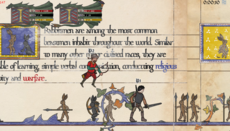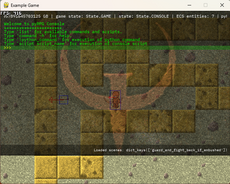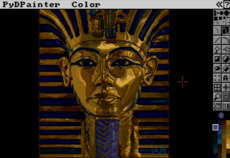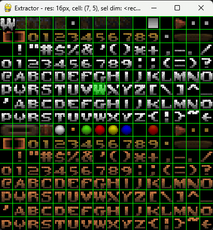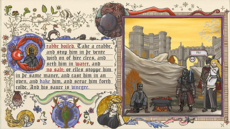Spritesheet — wiki
While teaching myself how to use pygame I discovered a distinct lack of the ability
to handle sprite sheets. After some digging on the internet I came across a class
that did everything I needed. I cleaned up the code a bit and added an additional
function to load a strip of images.
# This class handles sprite sheets
# This was taken from www.scriptefun.com/transcript-2-using
# sprite-sheets-and-drawing-the-background
# I've added some code to fail if the file wasn't found..
# Note: When calling images_at the rect is the format:
# (x, y, x + offset, y + offset)
import pygame
class spritesheet(object):
def __init__(self, filename):
try:
self.sheet = pygame.image.load(filename).convert()
except pygame.error, message:
print 'Unable to load spritesheet image:', filename
raise SystemExit, message
# Load a specific image from a specific rectangle
def image_at(self, rectangle, colorkey = None):
"Loads image from x,y,x+offset,y+offset"
rect = pygame.Rect(rectangle)
image = pygame.Surface(rect.size).convert()
image.blit(self.sheet, (0, 0), rect)
if colorkey is not None:
if colorkey is -1:
colorkey = image.get_at((0,0))
image.set_colorkey(colorkey, pygame.RLEACCEL)
return image
# Load a whole bunch of images and return them as a list
def images_at(self, rects, colorkey = None):
"Loads multiple images, supply a list of coordinates"
return [self.image_at(rect, colorkey) for rect in rects]
# Load a whole strip of images
def load_strip(self, rect, image_count, colorkey = None):
"Loads a strip of images and returns them as a list"
tups = [(rect[0]+rect[2]*x, rect[1], rect[2], rect[3])
for x in range(image_count)]
return self.images_at(tups, colorkey)
Here is a quick example on how you would use this
import spritesheet
...
ss = spritesheet.spriteshee('somespritesheet.png')
# Sprite is 16x16 pixels at location 0,0 in the file...
image = ss.image_at((0, 0, 16, 16))
images = []
# Load two images into an array, their transparent bit is (255, 255, 255)
images = ss.images_at((0, 0, 16, 16),(17, 0, 16,16), colorkey=(255, 255, 255))
...
Here is a sprite strip animation iterator built on spritesheet.spritesheet
import spritesheet
class SpriteStripAnim(object):
"""sprite strip animator
This class provides an iterator (iter() and next() methods), and a
__add__() method for joining strips which comes in handy when a
strip wraps to the next row.
"""
def __init__(self, filename, rect, count, colorkey=None, loop=False, frames=1):
"""construct a SpriteStripAnim
filename, rect, count, and colorkey are the same arguments used
by spritesheet.load_strip.
loop is a boolean that, when True, causes the next() method to
loop. If False, the terminal case raises StopIteration.
frames is the number of ticks to return the same image before
the iterator advances to the next image.
"""
self.filename = filename
ss = spritesheet.spritesheet(filename)
self.images = ss.load_strip(rect, count, colorkey)
self.i = 0
self.loop = loop
self.frames = frames
self.f = frames
def iter(self):
self.i = 0
self.f = self.frames
return self
def next(self):
if self.i >= len(self.images):
if not self.loop:
raise StopIteration
else:
self.i = 0
image = self.images[self.i]
self.f -= 1
if self.f == 0:
self.i += 1
self.f = self.frames
return image
def __add__(self, ss):
self.images.extend(ss.images)
return self
And an example usage of sprite_strip_anim.SpriteStripAnim
"""
Sprite strip animator demo
Requires spritesheet.spritesheet and the Explode1.bmp through Explode5.bmp
found in the sprite pack at
http://lostgarden.com/2005/03/download-complete-set-of-sweet-8-bit.html
I had to make the following addition to method spritesheet.image_at in
order to provide the means to handle sprite strip cells with borders:
elif type(colorkey) not in (pygame.Color,tuple,list):
colorkey = image.get_at((colorkey,colorkey))
"""
import sys
import pygame
from pygame.locals import Color, KEYUP, K_ESCAPE, K_RETURN
import spritesheet
from sprite_strip_anim import SpriteStripAnim
surface = pygame.display.set_mode((100,100))
FPS = 120
frames = FPS / 12
strips = [
SpriteStripAnim('Explode1.bmp', (0,0,24,24), 8, 1, True, frames),
SpriteStripAnim('Explode2.bmp', (0,0,12,12), 7, 1, True, frames),
SpriteStripAnim('Explode3.bmp', (0,0,48,48), 4, 1, True, frames) +
SpriteStripAnim('Explode3.bmp', (0,48,48,48), 4, 1, True, frames),
SpriteStripAnim('Explode4.bmp', (0,0,24,24), 6, 1, True, frames),
SpriteStripAnim('Explode5.bmp', (0,0,48,48), 4, 1, True, frames) +
SpriteStripAnim('Explode5.bmp', (0,48,48,48), 4, 1, True, frames),
]
black = Color('black')
clock = pygame.time.Clock()
n = 0
strips[n].iter()
image = strips[n].next()
while True:
for e in pygame.event.get():
if e.type == KEYUP:
if e.key == K_ESCAPE:
sys.exit()
elif e.key == K_RETURN:
n += 1
if n >= len(strips):
n = 0
strips[n].iter()
surface.fill(black)
surface.blit(image, (0,0))
pygame.display.flip()
image = strips[n].next()
clock.tick(FPS)
page migrated to new wiki


